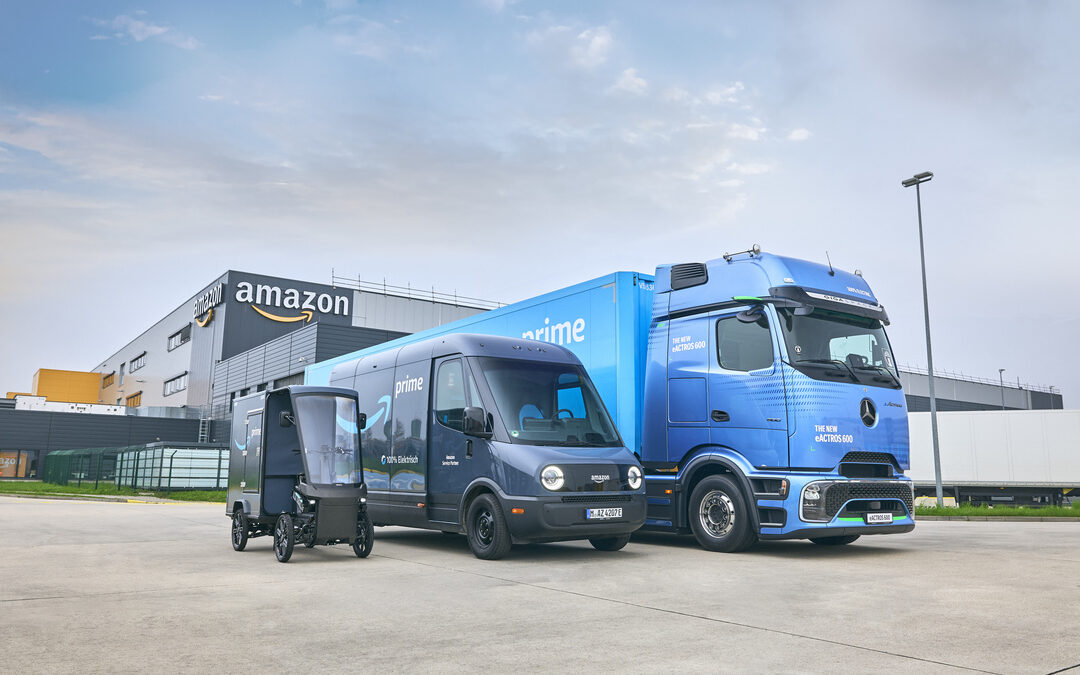Amazon Delivers 1.5B Packages by EVs, Hits 100% Clean Energy Goal in 2024
The e-commerce giant advances clean energy, EV logistics, and AI efficiency in its latest push toward net-zero emissions by 2040.
Amazon delivered a record 1.5 billion packages using electric vehicles in 2024, more than doubling its EV fleet to 31,400 globally and surpassing its India EV goal a year ahead of schedule, the company revealed in its 2024 Sustainability Report.
The e-commerce giant also retained its position as the world’s largest corporate purchaser of renewable energy for the fifth straight year, matching 100 percent of its global electricity usage with renewables.
The achievements come as part of Amazon’s broader commitment to reach net-zero carbon emissions by 2040 under The Climate Pledge, a goal it shares with over 549 corporate signatories.
“We’re not only scaling new technologies to reduce emissions across our own operations but enabling progress across entire industries,” said Chief Sustainability Officer Kara Hurst in the report.
Carbon and Energy Milestones
Despite a 6 percent increase in absolute carbon emissions in 2024 — to 68.25 million metric tons of carbon dioxide equivalent — Amazon cited an 11 percent increase in business activity and a 4 percent decline in carbon intensity, measured as emissions per dollar of gross merchandise sales.
Since signing The Climate Pledge in 2019, the company has reduced carbon intensity by 40 percent.
Amazon also:
- Procured 3.7 million gallons of sustainable aviation fuel
- Increased renewable diesel use 16-fold year-over-year to 4.7 million gallons
- Added 124 new renewable energy projects, bringing its total to 621, representing 34 GW of clean energy capacity
A key breakthrough was Amazon’s entry into nuclear energy, with investments in small modular reactors and a $500 million funding round in nuclear startup X-energy. These projects aim to add 960 MW of carbon-free energy to the U.S. grid by 2039.
Data Center Efficiency and AI Demands
To mitigate the surging energy demands of AI, Amazon Web Services recorded a global Power Usage Effectiveness of 1.15 in 2024, surpassing the cloud industry average of 1.25.
The company rolled out data center components that deliver 12 percent more compute power and 46 percent lower peak cooling energy use, without increasing water consumption.
AWS now has 70,000 customers using its custom-built Graviton chips, reducing carbon emissions by an estimated 12,000 metric tons. Amazon’s own use of the chips cut another 71,000 metric tons.
Packaging and Waste
Amazon eliminated plastic air pillows from all shipments in 2024 and reduced single-use plastic packaging by 16.4 percent globally. As part of its “Ships in Product Packaging” program, 12 percent of shipments were sent without Amazon-branded packaging.
The company also diverted 85 percent of its waste from landfills and donated or delivered 95 million meals to households in need. While the volume of food donations remained flat year-over-year, Amazon noted that the stable figure reflected a decrease in surplus food waste.
Buildings and Materials
To reduce its embodied carbon footprint, Amazon built 49 facilities using lower-carbon materials, thereby avoiding 77,000 metric tons of CO₂e. It deployed low-carbon concrete in 38 data centers and piloted hydrogen-reduced steel for the first time in a commercial data center.
AWS also updated its global design standards to require concrete with 35 percent less embodied carbon than the industry average.
Community and Workforce
Amazon committed $2.2 billion to create or preserve more than 21,000 affordable homes and surpassed its upskilling goal, training over 439,000 U.S. employees since 2021. Its artificial intelligence skills training initiative, launched in 2023, has already reached over 2 million people.
The company also expanded its Amazon Future Engineer program to reach 7.8 million underserved students globally.
With energy demands growing due to AI and cloud services, Amazon acknowledged the challenges of decarbonization at scale. The company emphasized the need for continued innovation, supplier engagement, and policy collaboration.
“We recognize that progress will not always be linear,” the report noted. “But we remain focused on serving our customers better, faster, and with fewer emissions.”
Nirmal Menon
Related posts
Subscribe
Error: Contact form not found.


